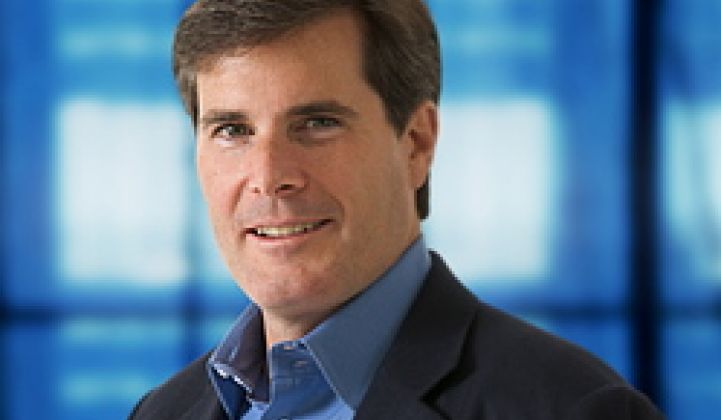Scott Sandell, a partner at venture capital firm New Enterprise Associates (NEA), sits on the boards of Bloom Energy, Fisker Automotive, SolFocus, and Heliovolt. Those four firms have received a total approaching $2 billion in venture capital and loans over the last decade.
With a crow's-nest seat at those firms, Sandell has some insights into the fuel cell, automotive, and solar markets, as well as the venture capital environment in general, which he shared with me in an interview earlier this week.
The State of Venture Capital and Cleantech VC
"It's the most exciting time since I joined the industry in 1996," said Sandell. According to the investor, there are now more angel investors and the amount of fundraising is recovering,
There is still an enormous contraction under way -- but it is a meritocracy: "LPs care that they're going to make money." Sandell agreed that there will be an increased concentration among a smaller number of firms.
There remains plenty of capital for capital-efficient firms, according to Sandell, as well as openings for medium-capital-intensive firms that will need $30 million to $50 million over the course of their startup lifetime. "But funding a highly capital intensive firm in cleantech will be very hard."
Sandell suggests that the role of the VC is as much about being a visionary and futurist as it is about having deep domain experience. He adds, "I don't claim to be an expert on most things I invest in, but I'm good at finding people who know a lot."
That brings up the funding story of Bloom Energy.
Funding Bloom Energy
Krishna ‘Kittu’ Kolluri, now a partner at NEA, was the CEO at an NEA-funded startup, Neoteris. He was an advisor to KR Sridhar of fuel cell firm Bloom Energy and brought the company to Sandell's attention. Sandell spoke to Sridhar, googled "solid oxide fuel cell," and looked over a one-page executive summary of the firm. Sandell called NEA venture partner and Nobel Prize winner Arno Penzias to take a look.
Penzias had a background in some of the technologies that go into a fuel cell and dismissed the fuel cell technology out of hand -- although he agreed to meet the Bloom CEO. At this point, Sandell went on a brief vacation.
Sandell returned to see Bloom Energy going through some of the later stage partner diligence. Penzias had seen the light and had driven the deal through.
Since then, Bloom has staffed up to hundreds of people and shipped more than 100 of their $800,000 SOFC-based, natural gas-fueled distributed generation units. Sandell sees them as having reached a point of "rapid and vital cost reduction," and someday serving as a case study for young companies taking on more mature technologies.
SolFocus and CPV
"The CPV market has evolved in a non-obvious way," said Sandell. It took longer to reach commercialization than expected, but is now ramping from 300-kilowatt deployments, to single-digit-megawatt deployments, to 30-megawatt projects.
He notes that CPV is being viewed as a complement to CSP installations or even as a CSP substitute when water issues come to the fore in high-DNI regions.
Sandell is seeing opportunities for SolFocus in far-flung places -- the Mediterranean, Saudi Arabia, northern Africa -- and these are the tip of the iceberg. "We're seeing some very large potential in the mining industry or in places dependent on diesel being trucked up mountainsides," Sandell said. He is also seeing enormous gigawatt-scale potential in western China.
"Investing in an automotive company is not for the faint of heart"
It's been 30 years since a new automotive company was founded, according to Sandell -- with the notable exception of Tesla. Fisker Automotive in Irvine, California seems to Scott to be an "extraordinary company." He believes that "you can sense something very different at the firm, no matter who you speak with."
Fisker Automotive is now officially producing cars in Finland and will soon be shipping them to the U.S. (Sandell expects to be driving his in September.)
Fisker has raised more than $1 billion in VC funding, loans, and grants.
Greentech Opportunities
Sandell summed up his take on venture capital investing this way: "I look for the extremely strong value proposition. If the value proposition is a little better -- no one's going to take the risk." But if the idea is "tremendously better," then "VCs will take the risk; great executives will join in" and a few brave customers will take the risk, as well.
"The problems that I've been looking for solutions for are clean water and energy storage. The problems are so large that for anyone who has a really disruptive innovation -- I think there's a phenomenal opportunity."
***
NEA has made at least 11 solar investments, some questionable (Konarka) and some a bit more inspired (Solar Junction, Suniva).
Here's NEA's solar portfolio:
1BOG: solar aggregator, price negotiator and educator
Astrowatt: thin silicon wafers, silicon-on-metal technology
Azuray: microinverters
Bandgap Engineering: nanowire-enhanced silicon
Konarka: organic solar cells
Heliovolt: CIGS solar panels
Solar Junction: CPV semiconductors
Skyline Solar: medium CPV with silicon
Solar Storage: 24-hour enterprise-scale solar power
SolFocus: CPV
Suniva: high-efficiency c-Si
NEA's other greentech investments include Opower, Serious Materials, Soraa, Svaya, Shenghui Lighting, Gridpoint, Glacier Bay, Deeya Energy, Illumitex, Boulder WindPower, Nordic WindPower, and Agni Corporation.



